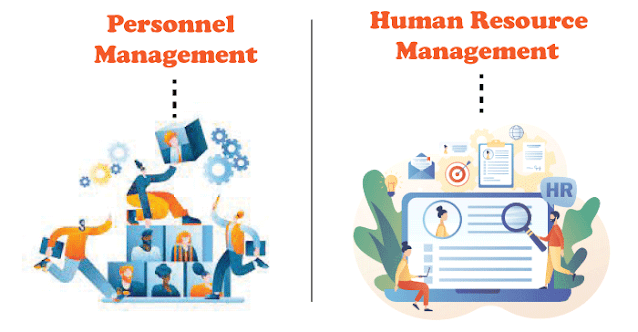Distinguishing Human Resource Management from Personnel Management
Difference between
Human Resource Management & Personnel Management
Human Resource Management and Personnel Management
HRM is a modern approach that integrates human resource policies with business
objectives. It focuses on employee engagement, development, and motivation to
enhance organizational performance. HRM includes strategic workforce planning,
continuous training, performance-based compensation, and fostering a flexible
and inclusive work environment. By prioritizing employee well-being, HRM helps
businesses achieve long-term success and adaptability in changing markets.
Personnel
management, on the other hand, is a traditional and administrative function
primarily concerned with employment-related tasks such as recruitment, payroll,
compliance with labour laws, and maintaining employee records. It operates with
a centralized decision-making structure and focuses on ensuring that employees
fulfill their job responsibilities according to predefined rules and
regulations. Unlike HRM, personnel management does not emphasize employee
development or strategic workforce planning.
|
Aspect |
Human
Resource Management (HRM) |
Personnel
Management |
|
Definition |
Strategic approach to workforce management aligning HR policies with business
objectives |
Traditional
approach focusing on employee administration |
|
Focus |
Employee
development, motivation, and engagement |
Compliance,
payroll, and task-oriented management |
|
Employee
View |
Employees
are assets contributing to organizational success |
Employees
are resources to be managed for productivity |
|
Training
& Development |
Focuses
on continuous learning and skill enhancement |
Limited
to basic job-related training |
|
Work
Environment |
Encourages
innovation, job satisfaction, and flexibility |
Task-oriented
with rigid job structures. |
Advantages
of HRM Over Personnel Management
- Higher Employee Engagement:
HRM fosters a participative culture, improving job satisfaction and
motivation.
- Increased Productivity:
Performance-driven strategies ensure employees work efficiently.
- Better Talent Retention:
A strategic approach to employee growth reduces turnover.
- Enhanced Organizational Agility:
HRM allows companies to adapt to changing business environments.
- Workplace Innovation:
Encouraging creativity and development improves competitiveness.
Conclusion
While personnel management remains relevant for administrative tasks, HRM is a
more dynamic and strategic approach that enhances employee satisfaction and
business performance. Organizations that shift from personnel management to HRM
can achieve long-term success by fostering a motivated and engaged workforce.
References
- Armstrong, M. (2020). Armstrong’s
Handbook of Human Resource Management Practice. Kogan Page.
- Dessler, G. (2019). Human Resource
Management (16th Edition). Pearson.





Personnel Management is a traditional, administrative approach focused on hiring, payroll, and compliance, while HRM is a modern, strategic approach that prioritizes employee development, engagement, and alignment with business goals.
ReplyDeleteHRM plays a significant role in administrative tasks while PM plays a vital role in employee performance and satisfaction. both roles are very important for a organization.
ReplyDeleteThe transformation from PM to HRM has opened a chamber of new possibilities for organizations. Even though the complexity of operations has increased, so has the technology and other supporting materials. Thus HRM is evolving at an impressive pace.
ReplyDeletePersonnel management primarily focuses on ordinary activities, such as employee hiring, remunerating, training, and harmony. On the contrary, human resource management focuses on treating employees as valued assets, which are to be valued, used and preserved.
ReplyDeleteClearly explained & Great article
ReplyDeleteEarned knowledge regard PM & HRM,
ReplyDeleteWell said.
HRM's strategic method not only gets workers more involved but also makes sure that workforce planning fits with company goals, which is important for long-term success. Good article, and thanks for sharing with us.
ReplyDeleteThis breakdown is very informative! It’d be great to explore how small organizations can gradually transition from traditional personnel management to strategic HRM models.
ReplyDelete